
Nepenthes villosa, or the villose pitcher-plant, is a tropical pitcher plant endemic to Mount Kinabalu and neighbouring Mount Tambuyukon in northeastern Borneo. It grows at higher elevations than any other Bornean Nepenthes species, occurring at elevations of over 3,200 m (10,500 ft). Nepenthes villosa is characterised by its highly developed and intricate peristome, which distinguishes it from the closely related N. edwardsiana and N. macrophylla.
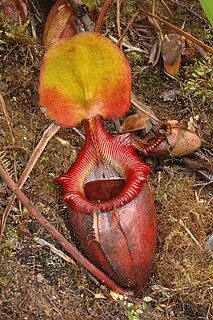
Nepenthes × kinabaluensis, or the Kinabalu Pitcher-Plant, is the natural hybrid between N. rajah and N. villosa. It was first collected near Kambarangoh on Mount Kinabalu, Borneo by Lilian Gibbs in 1910 and later mentioned by John Muirhead Macfarlane as "Nepenthes sp." in 1914. Although Macfarlane did not formally name the plant, he noted that "[a]ll available morphological details suggest that this is a hybrid between N. villosa and N. rajah". It was finally described in 1976 by Shigeo Kurata as N. × kinabaluensis. The name was first published in Nepenthes of Mount Kinabalu, but was a nomen nudum at the time as it lacked an adequate description and information on the type specimen. The name was subsequently published validly by Kurata in 1984.
Lobobasis is a monotypic moth genus in the family Erebidae. Its single species, Lobobasis niveimaculata, is found from the Indian state of Sikkim, Bhutan and Sundaland to Queensland, the Solomon Islands and New Guinea. The habitat consists of lower montane forests, upper montane forests and various types of lowland forests. Both the genus and species were first described by George Hampson in 1896.
Hoploscopa is a genus of snout moths in the subfamily Heliothelinae of the family Crambidae. The genus was described by Edward Meyrick in 1886, with Hoploscopa astrapias as type species.
Crinocula is a monotypic moth genus of the family Noctuidae erected by Karl Jordan in 1896. Its only species, Crinocula kinabaluensis, was first described by Walter Rothschild in 1896. It is found in Borneo.

Asota is a genus of moths in the family Erebidae first described by Jacob Hübner in 1819. Species are widely distributed throughout Africa, India, Sri Lanka, Myanmar, the Malayan region and tropical parts of the Australian region.
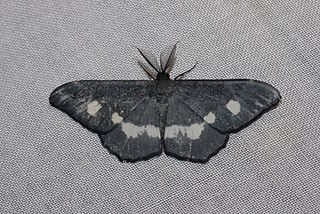
Hyposidra is a genus of moths in the family Geometridae first described by Achille Guenée in 1857.

Giganteopalpus is a monotypic moth genus in the family Sphingidae first described by Adolph Huwe in 1895. Its only species, Giganteopalpus mirabilis, described by Walter Rothschild in 1895, is known from Sundaland.

Asota caricae, the tropical tiger moth, is a species of noctuoid moth in the family Erebidae. It is found from the Indo-Australian tropics of India and Sri Lanka to Queensland and Vanuatu.

Asota egens is a species of noctuoid moths in the family Erebidae. It is found from Japan and the Oriental tropics, east to New Guinea.
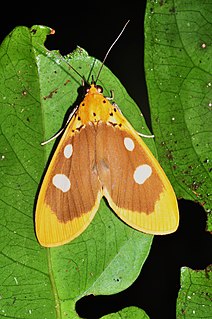
Asota javana is a moth of the family Erebidae first described by Pieter Cramer in 1780. It is found in Sundaland, the Philippines, Sulawesi and on Sula Island.
Asota paphos is a moth of the family Erebidae first described by Johan Christian Fabricius in 1787. It is found from the north-eastern Himalayas to Sundaland.
Asota albiformis is a moth of the family Erebidae first described by Charles Swinhoe in 1892. It is found in Borneo, the Philippines, Sulawesi and the Moluccas.
Asota antennalis is a moth of the family Erebidae first described by Walter Rothschild in 1897. It is found on Sulawesi and the Sumatra.
Asota dohertyi is a moth of the family Erebidae first described by Walter Rothschild in 1897. It is found on Sulawesi.
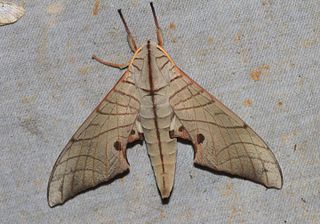
Marumba juvencus is a species of moth of the family Sphingidae first described by Walter Rothschild and Karl Jordan in 1912.
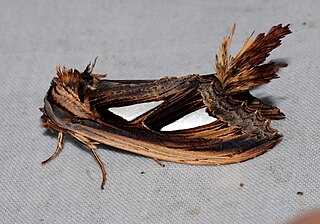
Tarsolepis is a genus of moths in the family Notodontidae erected by Arthur Gardiner Butler in 1872.

Xyleutes is a genus of moths belonging to the family Cossidae.
Groenendaelia is a monotypic moth genus in the family Cossidae. Its only species, Groenendaelia kinabaluensis, is found in Sundaland, including Borneo. The habitat consists of montane forests and lowland areas.
Utivarachna is a genus of Asian araneomorph spiders in the family Trachelidae first described by Kyukichi Kishida in 1940. It was largely ignored until Christa L. Deeleman-Reinhold revised the sac and ground spiders in 2001, transferring some species from Trachelas and adding several new ones. The genus was further expanded in 2014 and 2015.
This page is based on this
Wikipedia article Text is available under the
CC BY-SA 4.0 license; additional terms may apply.
Images, videos and audio are available under their respective licenses.











